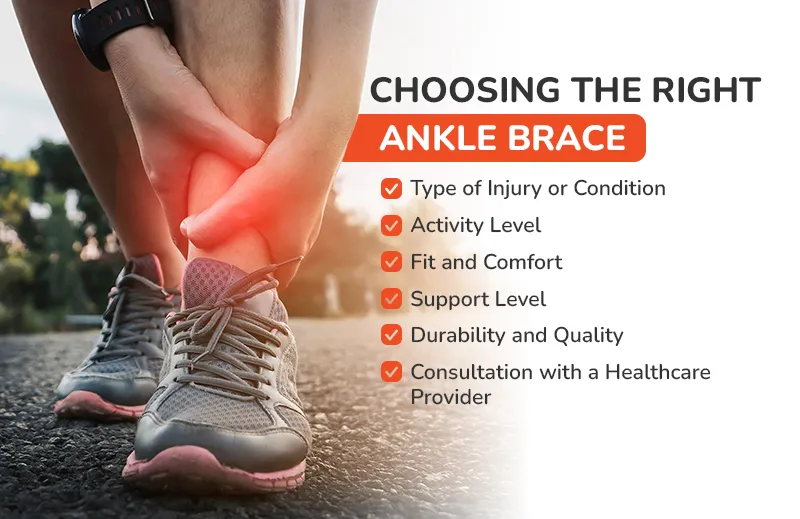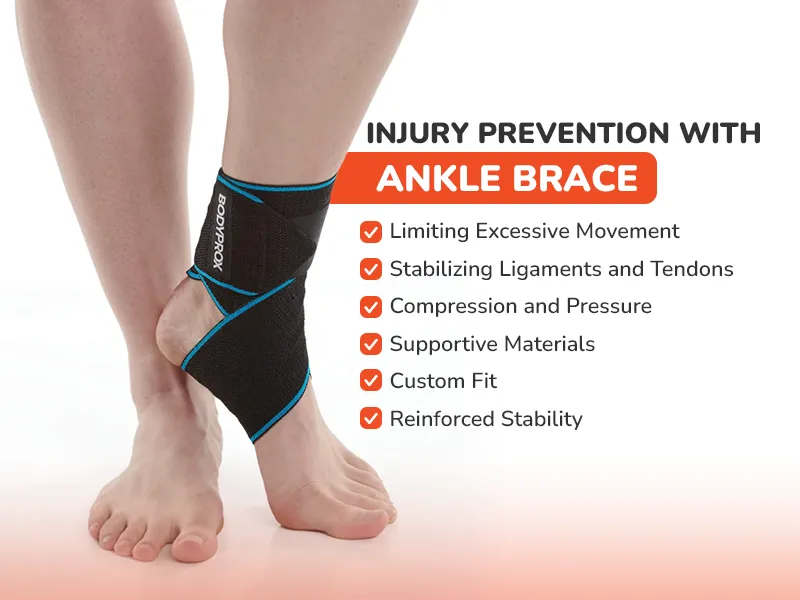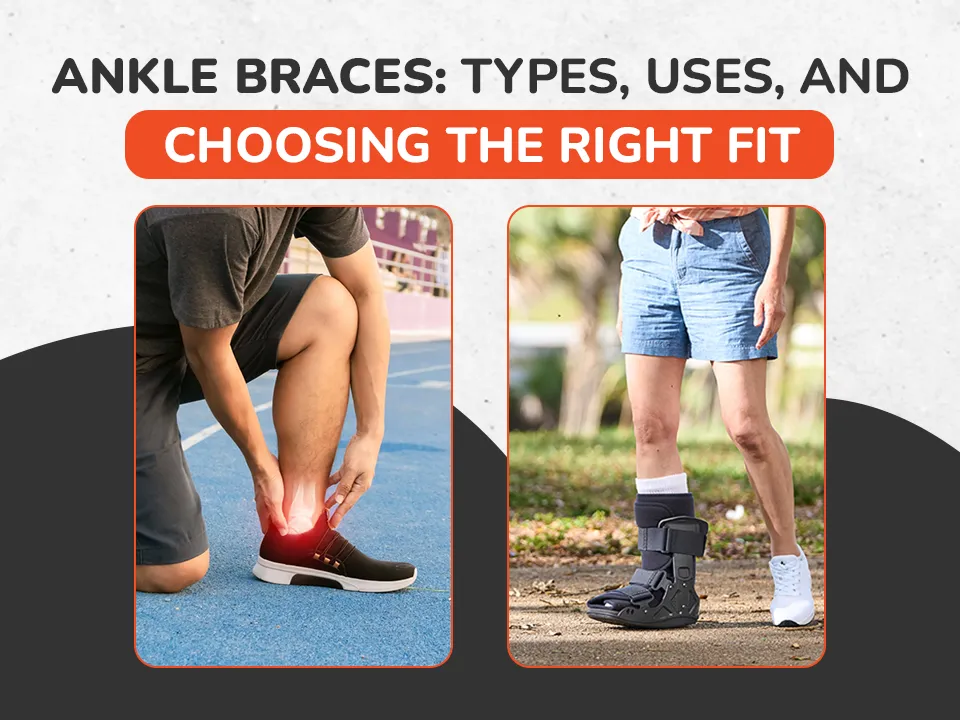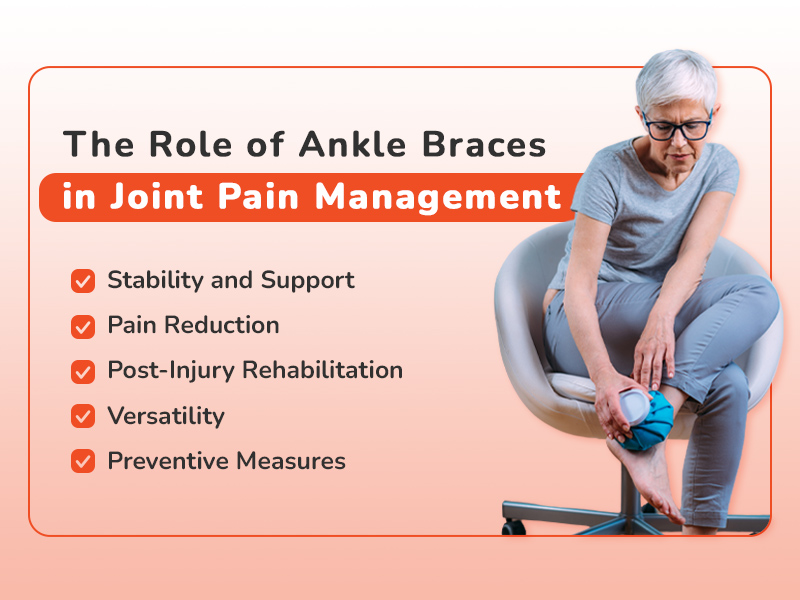Ankle Braces: Types, Uses, and Choosing the Right Fit
Ankles are remarkable joints that provide stability and support, allowing us to walk, run, jump, and engage in various activities. However, they are also vulnerable to injuries, especially for those who lead an active lifestyle or have previously experienced ankle issues. This comprehensive guide will delve into the world of ankle braces, shedding light on their importance in safeguarding your ankle health. Whether you’re an athlete looking to prevent injuries or someone on the path to recovery from an ankle sprain, understanding the types of ankle braces and how to choose the right one is essential for maintaining the well-being of your ankles.
Types of Ankle Braces
A wide array of ankle braces is available for ankle support and protection, each tailored to specific purposes and conditions. In this comprehensive section, we will delve into the diverse world of ankle braces, helping you thoroughly understand the various types and their applications. With this knowledge, you’ll be well-prepared to choose the perfect ankle brace that aligns with your unique requirements.
The Types of Ankle Braces Include:
- Lace-up ankle braces: Known for their versatility, they provide a customizable fit and targeted support. They are ideal for athletes to prevent injuries or recover from ankle sprains.
- Sleeve ankle braces: Sleeve-style ankle braces offer a snug, lightweight option for mild support and compression. They are often used for preventing minor injuries and providing general stability during physical activities.
- Stirrup ankle braces: These braces feature a stirrup-like design that cradles the ankle, offering stability and preventing excessive side-to-side motion. They are commonly used for moderate to severe ankle injuries.
- Hinged ankle braces: Hinged braces incorporate hinges that allow controlled movement while limiting excessive flexion and extension. They are suitable for recovering from injuries or protecting weak ankles during sports.
- Wrap-around ankle braces: Wrap-around ankle braces provide a secure fit and adjustable compression. They are favoured for their ease of use and are suitable for various ankle conditions, from mild to moderate.
Choosing the Right Ankle Brace
When selecting the perfect ankle brace, it’s essential to recognize that one size does not fit all. Ankle braces vary in design, support level, and intended use, and the right choice depends on several factors. To ensure that you’re making an informed decision and providing your ankles with the support they need, consider the following key factors when choosing the right ankle brace:

- Type of Injury or Condition: Begin by assessing your specific ankle injury or condition. Different braces are designed to address various issues, so understanding the nature of your problem is crucial. Whether you’re dealing with a sprain, instability, or chronic pain, matching the brace to your condition is the first step.
- Activity Level: Consider your activity level and the activities you engage in. Athletes involved in high-impact sports may require different support than someone with a sedentary lifestyle. The brace should align with the demands of your daily activities.
- Fit and Comfort: Comfort is paramount when selecting an ankle brace. A brace that doesn’t fit well or causes discomfort is less likely to be worn consistently. Look for braces with adjustable straps or multiple-size options to ensure a snug yet comfortable fit.
- Support Level: Ankle braces offer varying support, from mild to moderate to maximum support. Your healthcare provider can help determine the appropriate support level based on your condition and recovery needs.
- Durability and Quality: Invest in a high-quality brace made from durable materials. Ankle braces endure wear and tear, and a well-constructed brace will provide long-lasting support.
- Consultation with a Healthcare Provider: When in doubt, seek guidance from a healthcare provider or orthopedic specialist. They can offer valuable insights into the type of brace needed, the appropriate fit, and whether it is medically necessary for your condition.
Ankle Brace Fit Guide
Ensuring your ankle brace fits correctly is paramount to harnessing its full potential in providing support and comfort. This comprehensive section will take you through a step-by-step guide to achieving the perfect fit for your ankle brace. By following these guidelines, you can optimize its support and functionality, allowing you to confidently go about your daily activities without discomfort or concerns about inadequate support.
Step 1: Measure Your Ankle Circumference
The first step in finding the right fit for your ankle brace is accurately measuring your ankle’s circumference. To do this, you’ll need a flexible measuring tape, a piece of string, and a ruler. Wrap the measuring tape or string around the circumference of your ankle, just above the ankle bone. Ensure it’s snug but not too tight, as you want an accurate measurement of your ankle size.
Step 2: Determine Your Ankle Brace Size
Once you have your ankle circumference measurement, refer to the sizing chart the ankle brace manufacturer provided. Sizing charts typically match specific ankle circumference ranges to corresponding brace sizes. Select the size that aligns with your measurement. Remember that sizes can vary between brands and models, so it’s essential to consult the specific sizing information for the ankle brace you plan to purchase.
Step 3: Choose the Appropriate Type
Ankle braces come in various styles, including lace-up, sleeve, stirrup, hinged, and wrap-around designs. Different types offer varying levels of support and features. Your choice should align with your specific needs, such as the level of support required and the intended use. For example, lace-up ankle braces provide customizable compression and support, making them suitable for various activities, while hinged ankle braces offer enhanced stability for individuals recovering from injuries.
Step 4: Put It on Correctly
When you receive your ankle brace, ensure you put it on correctly. Follow the manufacturer’s instructions for wearing the brace. In most cases, lace-up ankle braces require you to loosen the laces fully, place your foot inside, and then gradually tighten the laces for a secure fit. Make sure the brace sits comfortably on your ankle without causing any discomfort or pressure points.
Step 5: Test for Proper Fit
Once your ankle brace is in place, perform a few simple movements to ensure it fits properly. Walk around, flex your ankle, and check for slipping or discomfort. Your ankle brace should provide support without restricting your range of motion or causing any irritation. If you experience any issues, such as excessive slipping or discomfort, consider adjusting the fit or trying a different size or type of brace.
Step 6: Seek Professional Guidance
If you have doubts about selecting the right ankle brace size or achieving the correct fit, don’t hesitate to seek guidance from a healthcare professional or an orthopedic specialist. They can offer valuable insights, recommend suitable brace options, and ensure you use them correctly.
Read More: Enhancing Mobility: The Role of Ankle Braces in Managing Joint Pain
Injury Prevention with Ankle Braces
Ankle injuries, particularly sprains, are prevalent among people of all ages and activity levels. Whether you’re an athlete, a fitness enthusiast, or someone who enjoys daily walks, the risk of rolling or twisting your ankle is ever-present. However, the good news is that wearing the right ankle brace can significantly reduce the risk of these injuries. In this section, we’ll delve into how ankle braces work to prevent ankle sprains and enhance stability, providing valuable insights into injury prevention.

- Limiting Excessive Movement: Ankle braces are designed to restrict excessive ankle movement, especially in lateral (side-to-side) directions. This limitation is crucial because many ankle sprains occur when the ankle rolls outward or inward beyond its normal range of motion. Ankle braces are a physical barrier, preventing the ankle from venturing into these vulnerable positions.
- Stabilizing Ligaments and Tendons: Ankle sprains often result from overstretching or tearing of the ligaments and tendons surrounding the ankle joint. Ankle braces support these structures, effectively reinforcing the ankle’s stability. By holding the ligaments and tendons in place, ankle braces reduce the likelihood of sudden tears or strains during activities.
- Compression and Pressure: Many ankle braces incorporate compression elements that exert gentle pressure on the joint and surrounding tissues. This compression helps reduce swelling and enhances proprioception – your body’s awareness of its position and movement. Improved proprioception can aid in balance and prevent missteps that lead to injuries.
- Supportive Materials: Ankle braces are typically constructed using sturdy yet lightweight materials that offer support without adding unnecessary bulk. These materials may include neoprene, nylon, or elastic fabrics. The choice of material depends on the brace’s intended use and the level of support required.
- Custom Fit: Ankle braces are available in various styles, from lace-up braces that allow for a customizable fit to sleeve-style braces that offer slip-on convenience. Regardless of the design, achieving a snug and secure fit is essential to maximize injury prevention. A well-fitted brace ensures that it stays in place during physical activities.
- Reinforced Stability: Certain ankle braces, such as hinged ankle braces or stirrup braces, provide reinforced stability by incorporating rigid components. These components act as additional supports, minimizing the risk of excessive ankle movement and providing peace of mind during quick direction changes.
Ankle Brace for Sprains: Treatment and Recovery
Experiencing an ankle sprain can be both painful and frustrating, but the road to recovery often involves using ankle braces. In this section, we’ll explore how ankle braces serve as valuable aids in treating and recovering sprained ankles. Whether recovering from a recent injury or looking to prevent re-injury, understanding the role of ankle braces is essential.
- Immobilization and Rest: After sustaining an ankle sprain, one of the primary goals is to immobilize the injured ankle and allow it to heal. Ankle braces provide the necessary stability to keep the ankle neutral, reducing the risk of further damage during the healing process. Ankle braces promote rest and minimize strain on the injured ligaments and tendons by limiting excessive movement.
- Reduced Swelling: Swelling is common following an ankle sprain and can impede the healing process. Many ankle braces incorporate compression elements that gently press against the injured area, helping to reduce swelling. Compression promotes the body’s natural healing mechanisms by improving blood circulation and lymphatic drainage.
- Pain Relief: Ankle sprains often come with varying levels of pain and discomfort. Ankle braces provide an external source of support, which can alleviate pain by stabilizing the injured joint. Reducing pain allows individuals to bear weight on the injured ankle more comfortably, facilitating a quicker return to daily activities.
- Prevention of Re-Injury: Once you’ve experienced an ankle sprain, the re-injury risk remains heightened, especially if the ligaments and tendons haven’t fully healed. Ankle braces act as a protective barrier, reducing the chances of rolling or twisting the ankle again. This is particularly important during recovery when the ankle is more vulnerable.
- Gradual Resumption of Activities: As your ankle heals, you’ll likely want to resume your normal activities gradually. Ankle braces, particularly those with adjustable features, allow for a controlled increase in activity levels. You can customize the level of support based on your comfort and the demands of your daily life.
- Physical Therapy Aid: Many individuals undergoing ankle sprain rehabilitation benefit from physical therapy. Ankle braces complement these therapies by providing stability during exercises and mobility drills. Physical therapists often recommend specific ankle brace types that align with the rehabilitation plan.
Conclusion: Ankle Braces: Your Path to Ankle Health and Wellness
Your ankles carry you through life’s adventures, and caring for them is paramount. Ankle braces are versatile tools that can support you to keep your ankles strong, whether you’re an athlete pushing your limits or simply navigating the challenges of daily life. From lace-up braces to hinged designs, an ankle brace suits your unique needs. By understanding the types of ankle braces, their uses, and the factors to consider when choosing the right fit, you can take a proactive approach to ankle health and wellness. Ankle braces can make a significant difference if you’re preventing injuries, aiding recovery, or simply seeking additional support. So, take the steps to protect your ankles, stay active, and embrace a life free from ankle discomfort and injuries.




